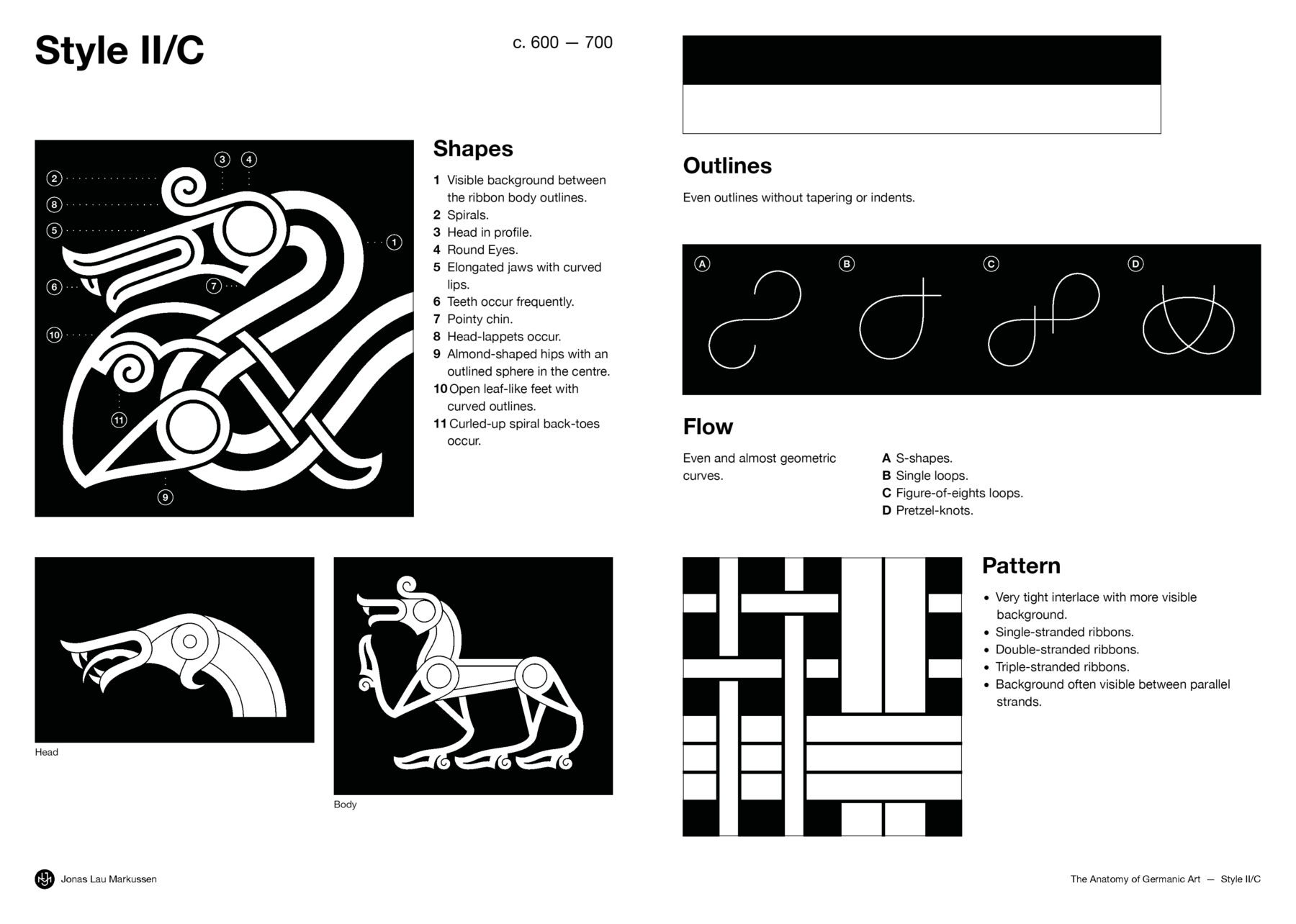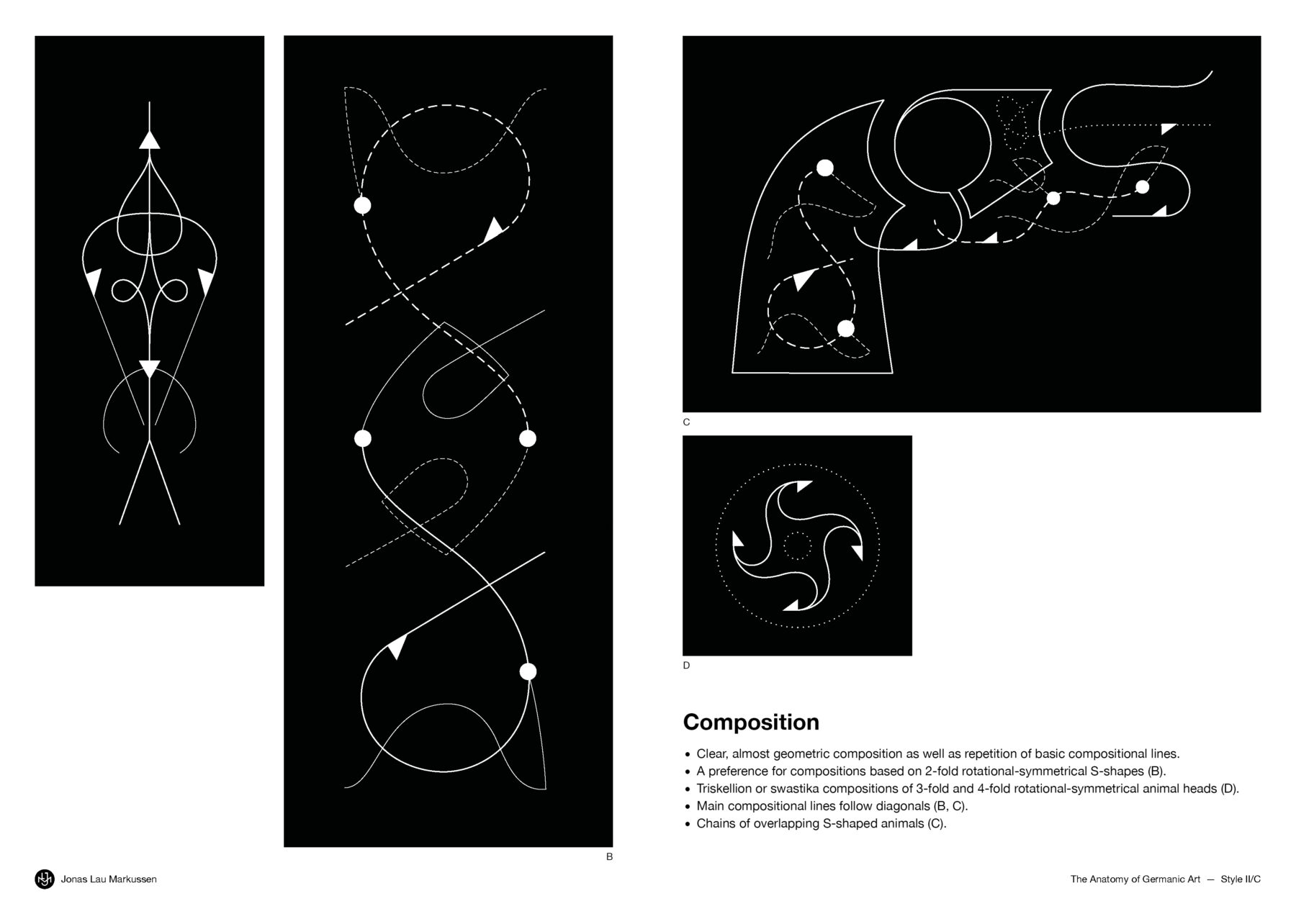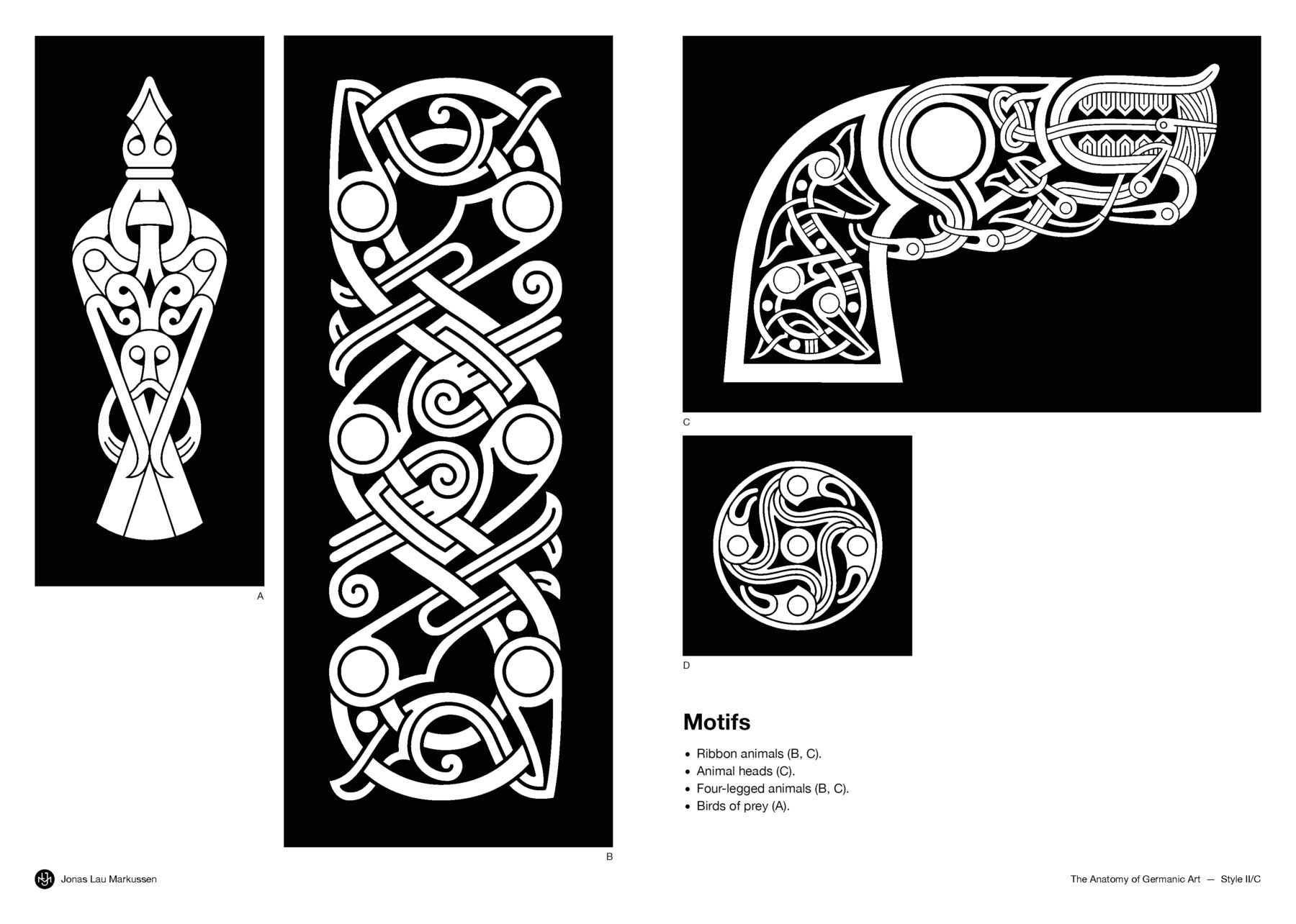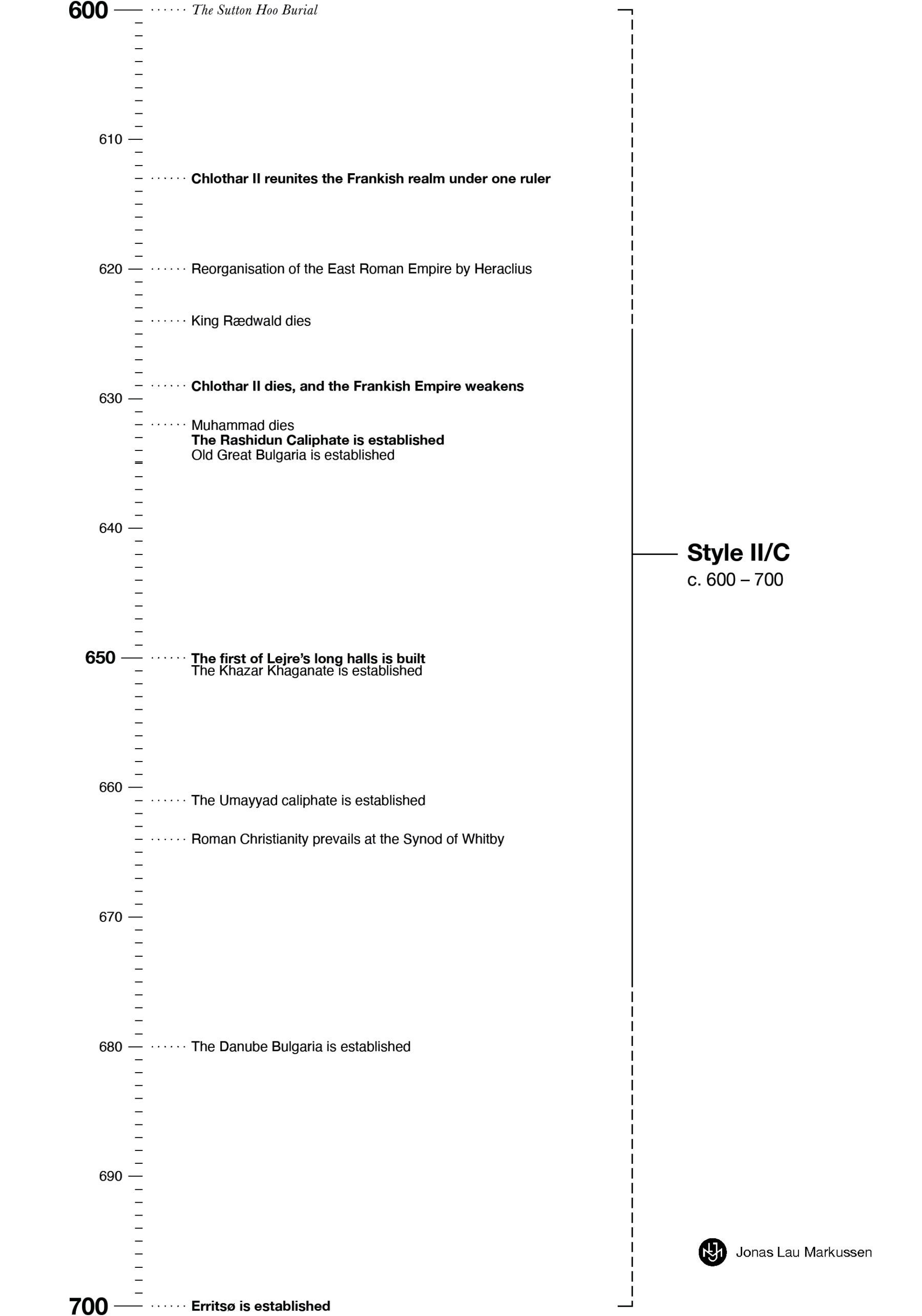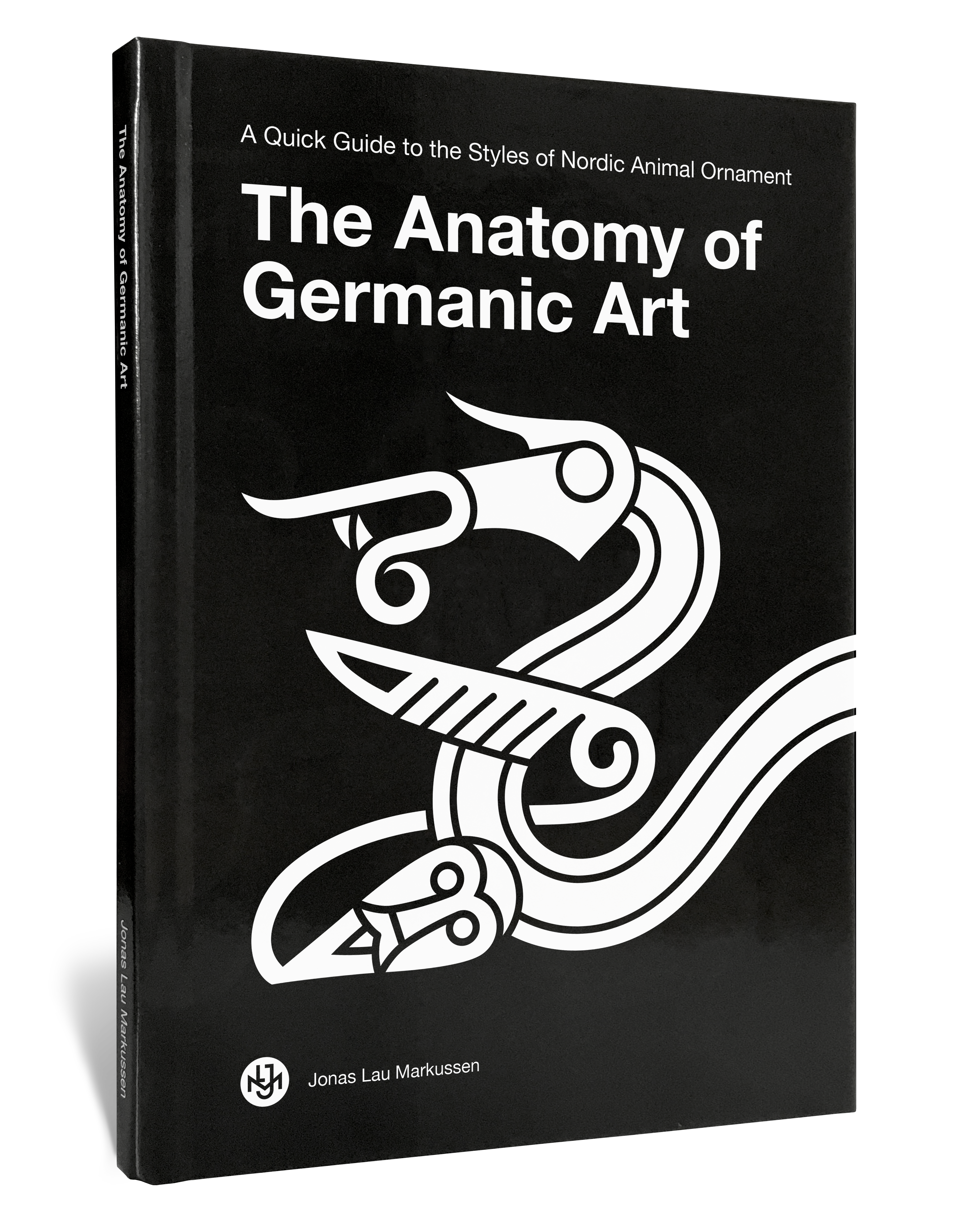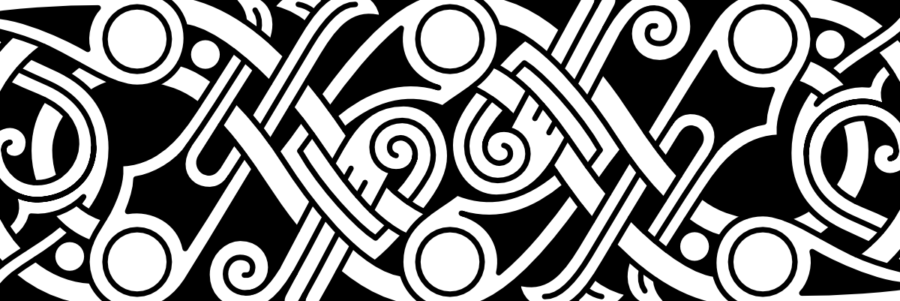
Style II/C
July 18, 2018
The Anatomy of Germanic Art
- Introduction
- Early Animal Style
- Style I
- Style II/B
- Style II/C
- Style II/D
The Anatomy of Style II/C
c. 600 – 700
Shapes
1. Visible background between the ribbon body outlines.
2. Spirals.
3. Head in profile.
4. Round Eyes.
5. Elongated jaws with curved lips.
6. Teeth occur frequently.
7. Pointy chin.
8. Head-lappets occur.
9. Almond-shaped hips with an outlined sphere in the centre.
10. Open leaf-like feet with curved outlines.
11. Curled-up spiral back-toes occur.
Outlines
Even outlines without tapering or indents.
Flow
A preference for geometric curves.
A. S-shapes.
B. Single loops.
C. Figure-of-eights loops.
D. Pretzel-knots.
Pattern
- Very tight interlace with more visible background.
- Single-stranded ribbons.
- Double-stranded ribbons.
- Triple-stranded ribbons.
- Background often visible between parallel strands.
Composition
- Clear, almost geometric composition as well as repetition of basic compositional lines.
- A preference for compositions based on 2-fold rotational-symmetrical S-shapes (B).
- Triskellion or swastika compositions of 3-fold and 4-fold rotational-symmetrical animal heads (D).
- Main compositional lines follow diagonals (B, C).
- Chains of overlapping S-shaped animals (C).
Motifs
- Ribbon animals (B, C).
- Animal heads (C).
- Four-legged animals (B, C).
- Birds of prey (A).
New Empires on the Rise
The East Roman Empire
Under Emperor Heraclius, the East Roman Empire faced immense challenges, including the devastating Persian and Roman Wars. Heraclius reorganised the administration, military, and economy to restore stability. His efforts laid the groundwork for the empire’s survival and adaptation.
The Caliphate
Following the prophet Muhammad’s death, the Rashidun Caliphate emerged. The Caliphate expanded rapidly, led by the four ‘rightly guided’ caliphs: Abu Bakr, Umar, Uthman, and Ali. It conquered vast territories, including Persia, Egypt, and parts of Syria.
Bulgaria
Old Great Bulgaria emerged as a formidable power in the heart of the Balkans. Under Khan Kubrat, the Bulgars forged a confederation that challenged Roman authority. Their influence extended across the Danube River, and their interactions with Constantinople shaped the region’s history.
The Khazar Khaganate
Situated between the Black Sea and the Caspian Sea, the Khazar Khaganate thrived as a multicultural hub. The Khazars, a Turkic people, controlled vital trade routes connecting Europe and Asia. Their capital, Itil (modern-day Astrakhan), buzzed with merchants, scholars, and diplomats from various backgrounds.
England
In England, the period witnessed a patchwork of kingdoms. Northumbria, Mercia, East Anglia, and Wessex vied for supremacy. Lesser kingdoms like Sussex, Essex, and Kent also played their part. War was endemic, as these realms clashed over territory and resources. Religious disputes added another layer of complexity. The Synod of Whitby in 664 settled the debate between Celtic Christianity practised in parts of England and Roman Christianity embraced by the southern kingdoms. The Roman tradition prevailed, aligning England more closely with continental Europe.
The Frankish Empire
Once divided among the Merovingian kings, the Frankish Empire saw a pivotal moment under Chlothar II. Chlothar reunified the kingdom, consolidating power and laying the groundwork for the Carolingian dynasty’s eventual rise.
Scandinavia
In Scandinavia, Lejre witnessed the construction of the first impressive 48-meter-long hall, a testament to the region’s growing prosperity. More than just buildings, halls like this served as symbols of authority, where kings held court, feasted, and made decisions that shaped their realms. Lejre’s importance is reflected in sagas, legends, and other written sources, associating it with the mythical royal family of the Skjöldungar (Scyldings). According to these sagas, Lejre was founded by King Skjold and served as the seat for the legendary Skjöldunga dynasty. In the epic poem Beowulf, the legendary hero of the same name roamed the Danish kingdom, with Lejre serving as the royal seat with its imposing hall. During this period, Borre in Viken, Norway, saw some of its first grave mounds erected, a testament to the region’s growing importance in Scandinavia.
Refining the Ribbon Interlace
Development
While the preceding Style II/B heavily features different identifiable types of beasts like birds of prey, boars, wolves, and serpents, most beasts in Style II/C are relatively stylised. It’s rarely possible to distinguish between heads of serpents, horses, or wolves. The only telltale sign is sometimes the animals’ limbs and body shape. The animal heads of Style II/C, with their elongated beak-like mouths, are often misinterpreted as birds. However, birds’ beaks in Germanic art are characteristically always curled up into spirals. The abstraction and stylisation of the animals and their characteristics are carried into the animals’ bodies and limbs. Whereas clear protruding animal heads are a prominent feature in Style II/B, the generically abstracted animal heads blend seamlessly into the knotwork patterns in Style II/C. The ribbon bodies are typically created only by the two parallel body-contour ribbons, usually leaving the space between them blank. There is a general affinity for more geometric shapes with stringent and sleek main compositional lines. The knotwork patterns are based on a clear mirror or rotational symmetry with evenly flowing S-curves and a simpler, repetitive geometric compositional structure.
Rectangular Brooches
The rectangular brooches are often some of the most evident examples of the typical characteristics of Style II/C. They display precise 2-fold rotational-symmetrical compositions of wavy S-shaped interlacing animal bodies. Their hips and eyes feature circular rivet-like shapes that disguise the animals’ anatomy, deliberately making them harder to discern.
Animal-shaped Brooches
Some of the most enticing works in the style are the animal-shaped brooches, which look like typical four-legged predatory beasts or horses. Their bodies are usually S-shaped, and they have large, round eyes.
Bird-shaped Brooches
While the bird-shaped brooches of birds in profile were common in Style II/B, a variation of the bird brooch also emerging in the early Germanic Iron Age gained prevalence in Style II/C. This type shows the bird seen in front, or rather from the top or back. While their overall shape is relatively uniform, the layout of wings and patterns varies quite a bit. They often also feature bearded men’s faces merged into their anatomy, and their wings are sometimes composed of animal heads seen in profile, implying that the bird is a shapeshifting being.
Harness Mounts
The prestige horse tack in this style usually displays the S-shaped animals typical for the style, with open bodies in pairs or juxtaposed in ribbon formation weaving into each other, creating wavy continuous patterns of animal bodies.
Round Brooches
Triskellion or swastika compositions of 3-fold and 4-fold rotational-symmetrical animal heads are common throughout the Germanic Iron Age, and not least in Style II/C, where the affinity for geometric shapes lends itself well to this type of design.
Examples
Examples on Gelmir.com →
A list of examples with photos, info and links to sources.
Bird-shaped brooch — Berg
Berg, Innlandet, Norway.
Kulturhistorisk Museum, Oslo, C65204.
Bird-shaped brooch — Foss Nordre
Foss Nordre, Viken, Norway.
Kulturhistorisk Museum, Oslo, C61472.
Bird-shaped brooch — Gaalaas
Gaalaas, Innlandet, Norway.
Kulturhistorisk Museum, Oslo, C61471.
Bird-shaped brooch — Holter
Holter, Viken, Norway.
Kulturhistorisk Museum, Oslo, C56532.
Bird-shaped brooch — Smørenge
Smørenge, Bornholm, Denmark.
Nationalmuseet, København, C35641.
Brooch — Arnestad
Arnestad, Vestland, Norway.
Universitetsmuseet i Bergen, Bergen, B10058.
Brooch — Ulstrup
Ulstrup, Sjælland, Denmark.
Nationalmuseet, København, C25060.
Horse harness mount
Eik, Telemark, Norway.
Kulturhistorisk Museum, Oslo, Ts12569/1.
Mount
Hamar, Hedmark, Norway.
Kulturhistorisk Museum, Oslo, C54135.
Oval animal-shaped brooch — Kvarøen Ytre
Kvarøen Ytre, Nordland, Norway.
Norges Arktiske Universitetsmuseum, Tromsø, Ts6377/c.
Round brooch — Bäcks
Bäcks, Gotland, Sweden.
Gotlands Museum, Visby, GFC7631.
Round brooch — Ollajvs
Ollajvs, Gotland, Sweden.
Gotlands Museum, Visby, GFC6303.
Shield mounts
Ultuna, Uppland, Sweden.
Historiska Museet, Stockholm, 371966.
